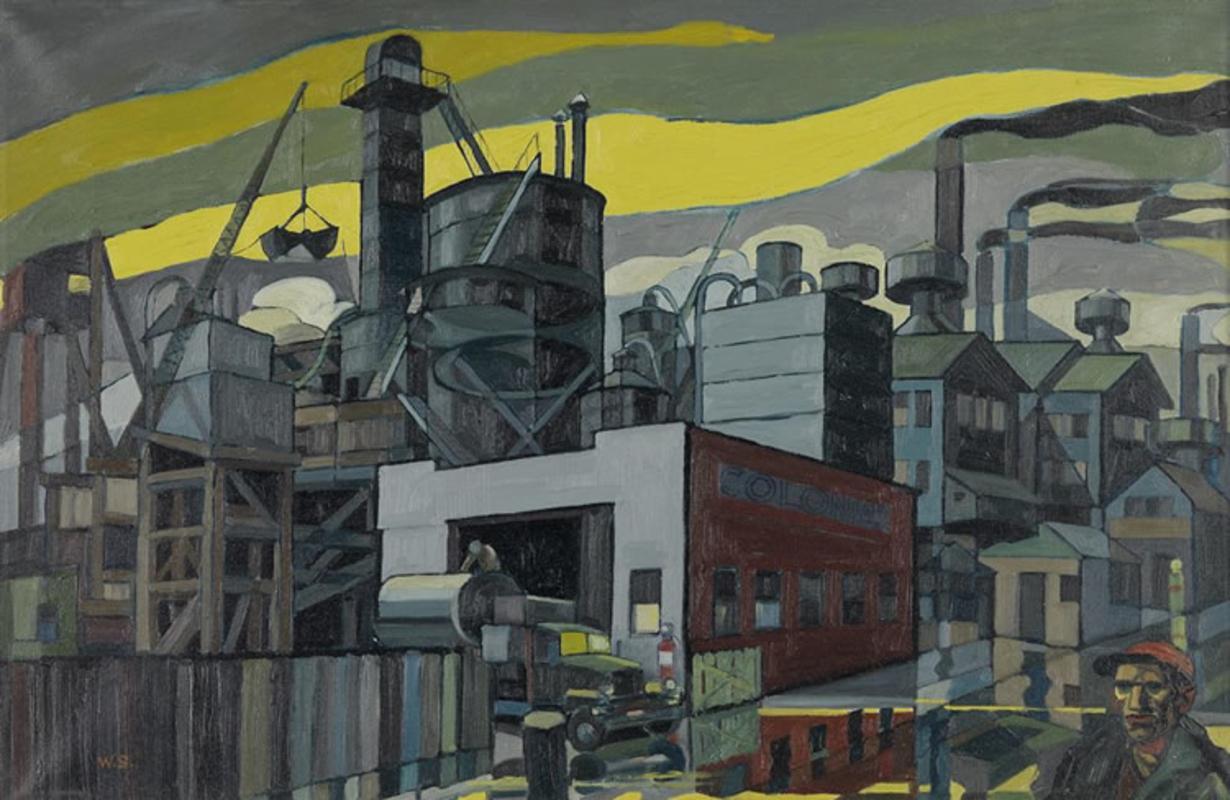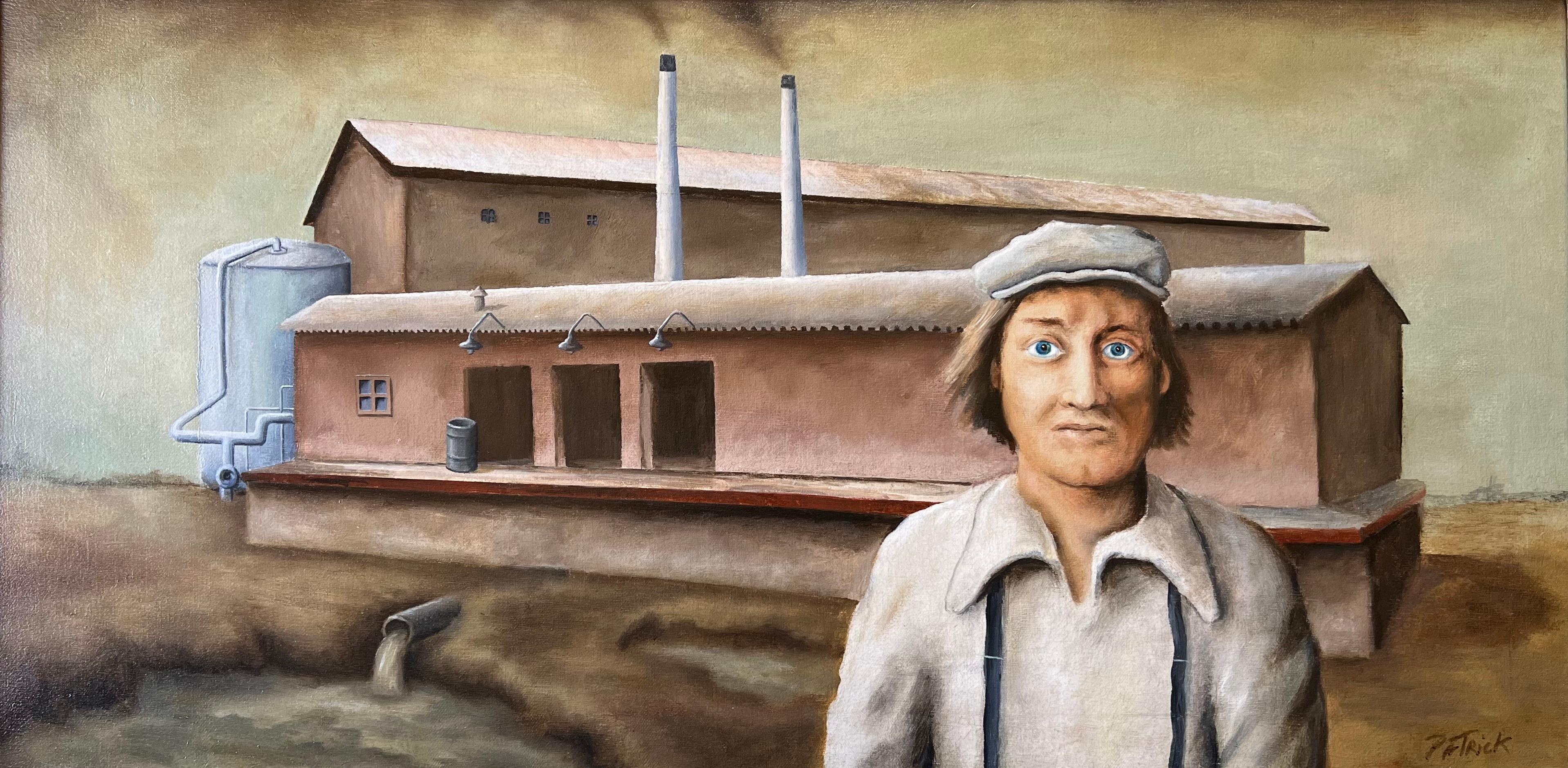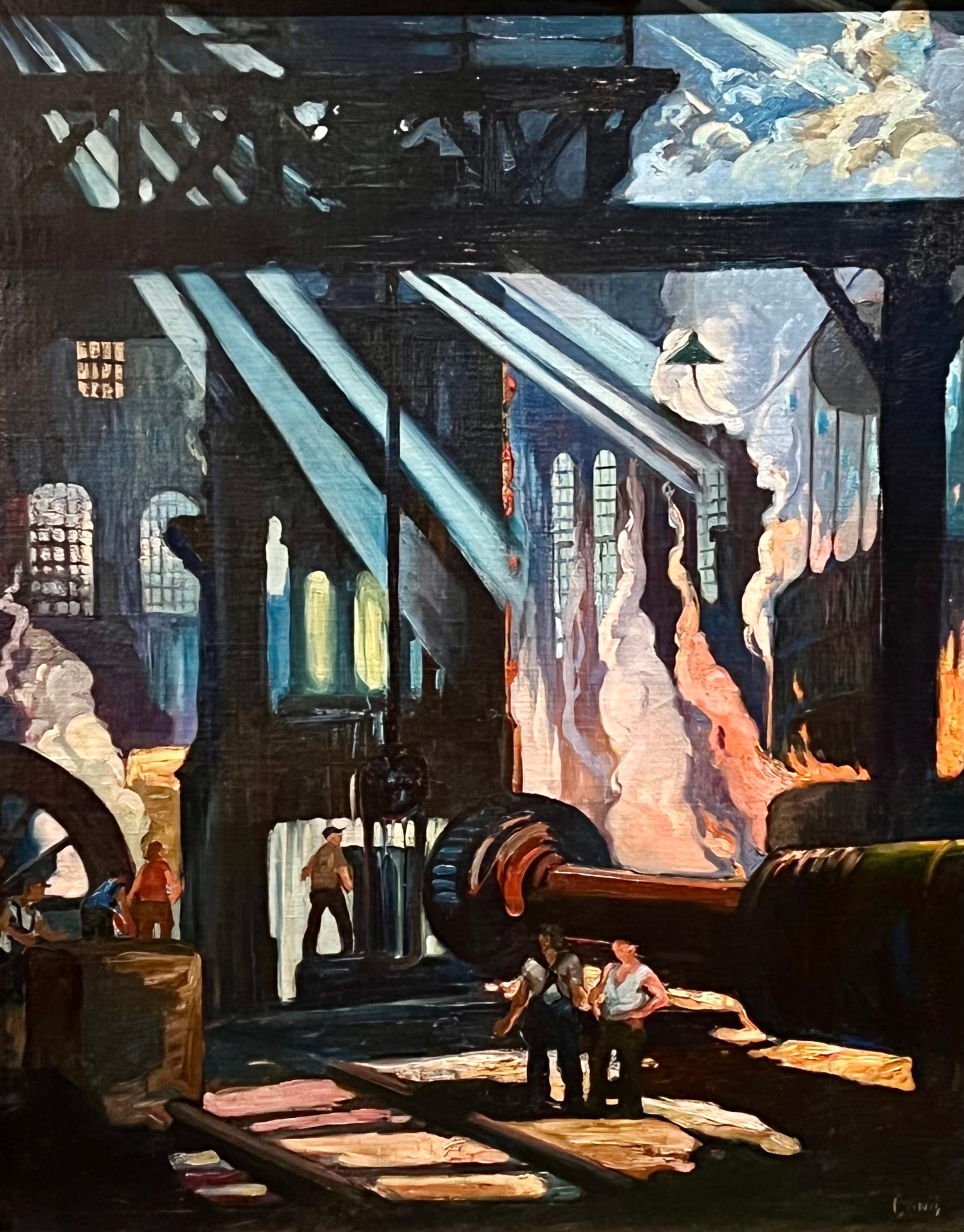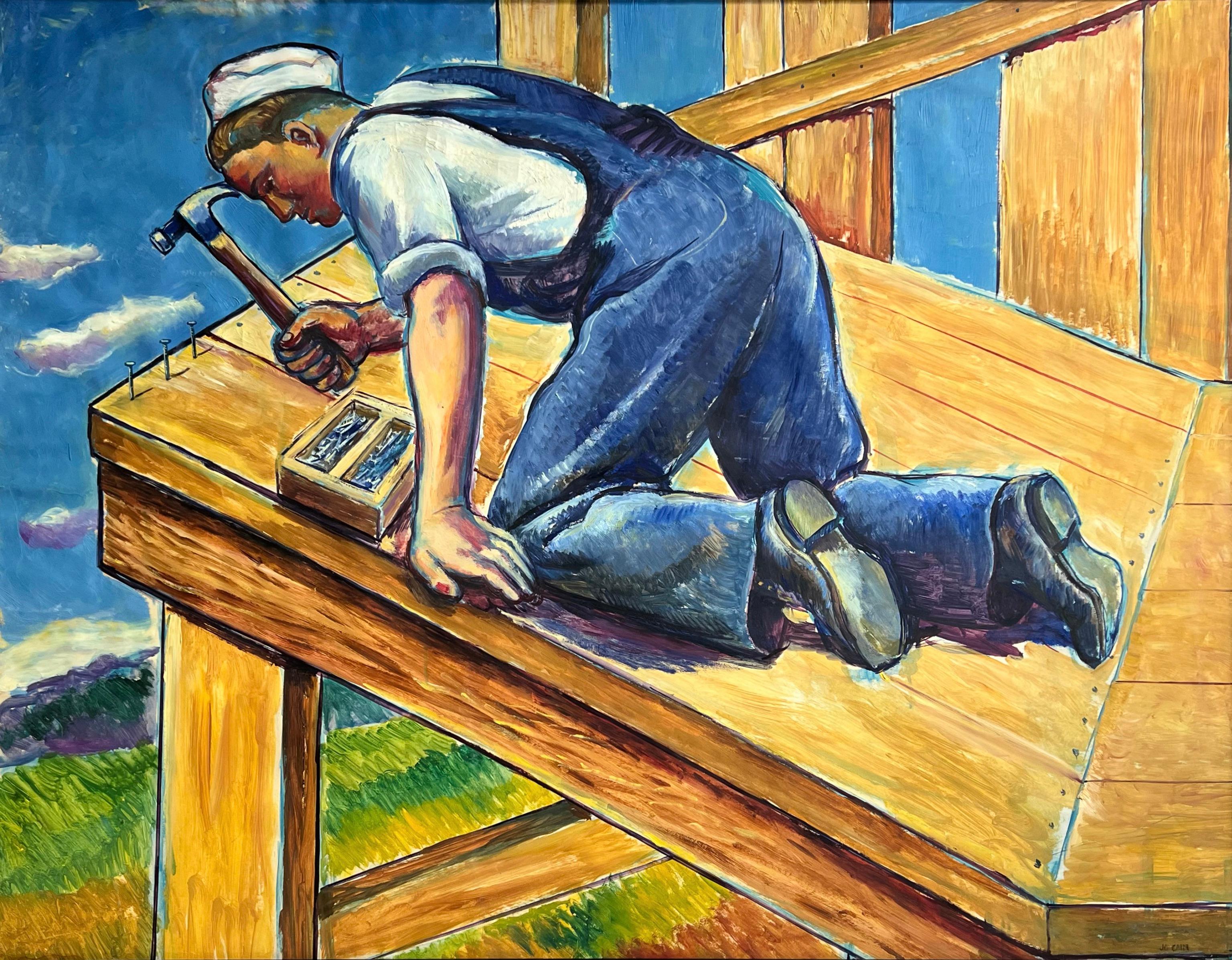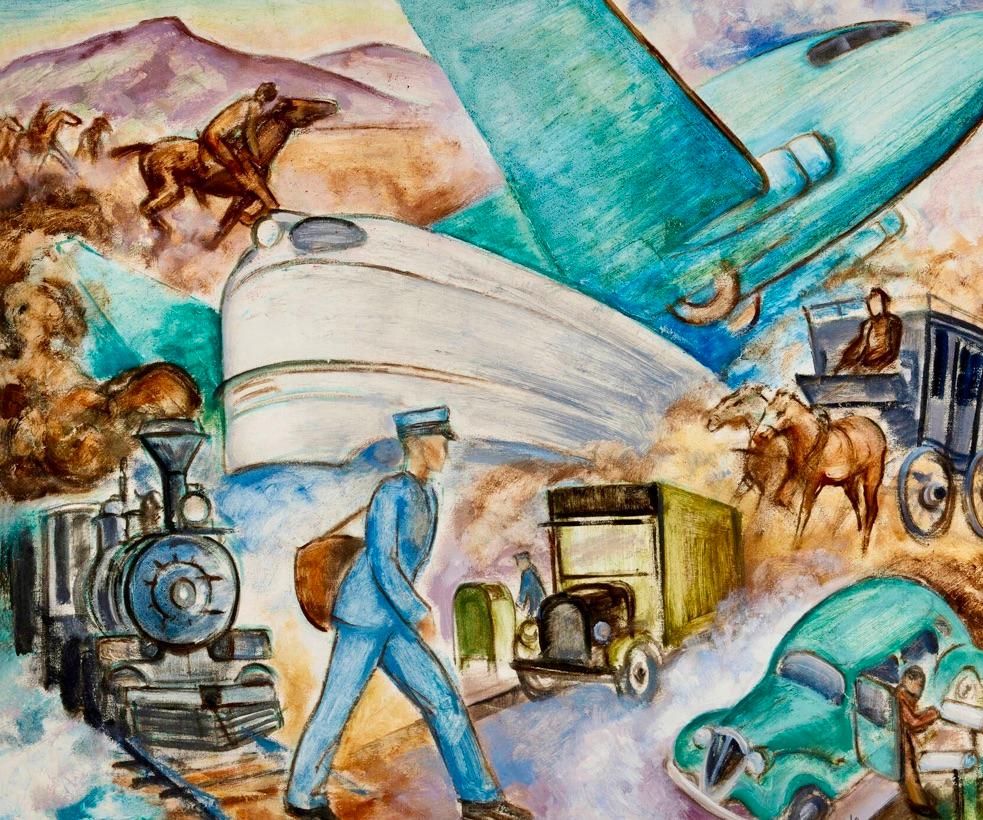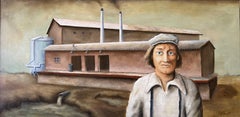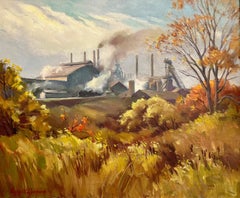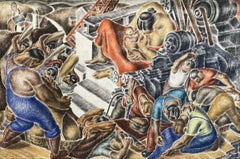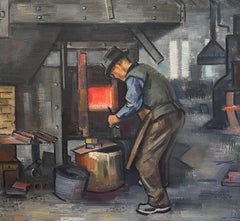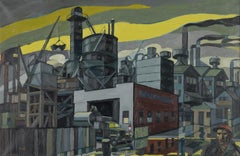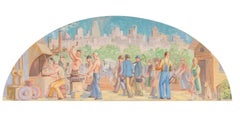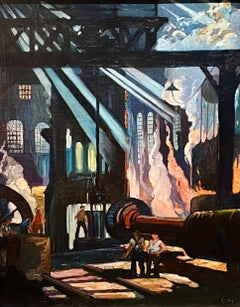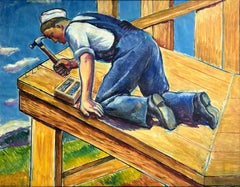Items Similar to Industry and Commerce
Want more images or videos?
Request additional images or videos from the seller
1 of 6
John BallatorIndustry and Commerce1936
1936
$12,000
£9,063.21
€10,469.41
CA$16,906.29
A$18,106.64
CHF 9,734.01
MX$219,915.77
NOK 122,993.92
SEK 112,610.08
DKK 78,225.63
About the Item
This mural study is part of our exhibition America Coast to Coast: Artists of the 1930s
Industry and Commerce, 1936, tempera on panel, 16 ½ x 39 ½ inches, signed verso “John Ballator, Portland Ore.” provenance includes: J.C. Penney Company, represented by Russell Tether Fine Arts Assoc.; presented in a newer wood frame
About the Painting
Industry and Commerce is a prime example of WPA Era muralism. Like a Mediaeval alter, this mural study is filled with icons, but the images of saints and martyrs are replaced with symbols of America's gospel of prosperity through capitalism. Industry and Commerce has a strong narrative quality with vignettes filling the entire surface. Extraction, logistics, design, power generation, and manufacturing for printing, chemicals, automobiles and metal products are all represented. To eliminate any doubt about the mural's themes, Ballator letters a description into the bottom of the study. Ballator also presents an idealized version of industrial cooperation, as his workers, lab-coated technicians and tie-wearing managers work harmoniously toward a common goal in the tidy and neatly designed environments. Although far from the reality of most industrial spaces, Ballator's study reflects the idealized and morale boosting tone that many mural projects adopted during the Great Depression.
About the Artist
John R Ballator achieved success as a muralist, lithographer, and teacher during the Great Depression. Born in Oregon, he studied at the Portland Museum Art School, the University of Oregon and at Yale University where he received a Bachelor of Fine Art. In 1936, Ballator was commissioned to paint a mural panel for the new Department of Justice Building in Washington DC, an important project that spanned five years with several dozen artists contributing a total of sixty-eight designs. Ballator completed murals for the St. Johns Post Office and Franklin High School, both in Portland, Oregon. He also contributed to the 1938 murals at Nathan Hale School in New Haven, Connecticut. During the late 1930s, Ballator taught art for several years at Washburn College in Topeka, Kanas, where he completed a mural for the Menninger Arts & Craft Shop before accepting a professorship at Hollins College in Roanoke, Virginia, where he became the department head and remained for over three decades, though he often summered in Oregon. While at Hollins, he founded the Roanoke Fine Arts Center. Ballator is listed in Who Was Who in American Art and other standard references.
- Creator:John Ballator (1909 - 1967, American)
- Creation Year:1936
- Dimensions:Height: 16.5 in (41.91 cm)Width: 39.5 in (100.33 cm)Depth: 3 in (7.62 cm)
- More Editions & Sizes:16.5 x 39.5Price: $12,000
- Medium:
- Movement & Style:
- Period:
- Condition:
- Gallery Location:Los Angeles, CA
- Reference Number:1stDibs: LU1859213057302
About the Seller
5.0
Vetted Professional Seller
Every seller passes strict standards for authenticity and reliability
1stDibs seller since 2022
18 sales on 1stDibs
Typical response time: 2 hours
- ShippingRetrieving quote...Shipping from: Los Angeles, CA
- Return Policy
More From This Seller
View AllFactory Worker
Located in Los Angeles, CA
This painting is part of our exhibition America Coast to Coast: Artists of the 1930s
Factory Worker, c. 1936, oil on canvas, signed lower right, 18 ¼ x 36 inches; exhibited in City ...
Category
1930s American Realist Figurative Paintings
Materials
Oil
Civilization
Located in Los Angeles, CA
Civilization, c. 1948, oil on canvas, signed lower left, 20 x 24 inches, label verso reads “Eugene M. Dyczkowski / Grand Inland, N. Y. / Civilization,” inscribed verso in the artist’...
Category
1940s American Realist Landscape Paintings
Materials
Canvas, Oil
Farm Tragedy (Untitled)
Located in Los Angeles, CA
Farm Tragedy (Untitled), c. 1930s, mixed media on plaster on panel, unsigned, 22 1/8 x 32 inches; label verso reads: "New York Artists Equity Association, New York, NY," provenance i...
Category
1930s American Modern Figurative Paintings
Materials
Mixed Media
Blacksmith (Untitled)
By Erle Loran
Located in Los Angeles, CA
Blacksmith (Untitled), 1936, oil on canvas, signed and dated lower right, 28 x 30 inches
Erle Loran was an influential American painter, art historian, and educator, renowned for h...
Category
1930s American Modern Figurative Paintings
Materials
Canvas, Oil
Quarry Workers
Located in Los Angeles, CA
This painting is part of our exhibition America Coast to Coast: Artists of the 1930s
Quarry Workers, c. 1930s, mixed media on board, unsigned, 24 x 24 inches, possibly exhibited at...
Category
1930s American Modern Figurative Paintings
Materials
Mixed Media
Street Cleaners
Located in Los Angeles, CA
This painting is part of our exhibition America Coast to Coast: Artists of the 1930s
Street Cleaners, c. 1940s, oil on canvas, signed lower right, 28 ¾ x 42 inches, Gallery Z...
Category
1940s American Modern Figurative Paintings
Materials
Oil
You May Also Like
"Colonial Sand and Stone Company, New York, " Industrial WPA Scene, Precisionist
By William Sharp
Located in New York, NY
William Sharp (1900 - 1961)
Factory on the River
Oil on canvas
20 1/2 x 28 1/2 inches
Initialed lower left: WS
Provenance:
Estate of the artist
Private Collection, New York
Swann Auction Galleries, American Art, June 13, 2019, Lot 178
Private Collection, New York
Colonial Sand and Stone Co., founded by Generoso Pope, was once the country’s largest sand and gravel business, providing the concrete for much of New York City’s skyline, including the Empire State Building, Rockefeller Center, Radio City Music Hall, airports and subways.
William Sharp was born on June 13, 1900, in Lemberg, Austria, where he attended college and the Academy for Arts and Industry. He later studied in Kraków, Poland, and in Berlin and Munich, Germany. Sharp began his career as a designer of stained-glass windows and as a painter of murals. He served in the German army during World War I. After the war he became a newspaper artist in Berlin and a well-known etcher.
Sharp drew political cartoons that were bitterly critical of the growing Nazi movement. As the influence of National Socialism intensified, he began to contribute drawings, under a pseudonym, to publications that were hostile to Hitler. After Hitler assumed power, Sharp was confronted with these drawings and told that he would be sent to a concentration camp. However, in 1934, he escaped to the United States.
His first newspaper assignment in America was making courtroom sketches for The New York Mirror...
Category
Mid-20th Century American Realist Landscape Paintings
Materials
Canvas, Paint, Oil
Industrial Mural Study, Veterans Memorial Building, Santa Barbara WPA American
Located in New York, NY
Industrial Mural Study, Veterans Memorial Building, Santa Barbara WPA American
Joseph Edward Knowles (1907-1980)
"Study for Industry Mural, Veterans Memorial Building, Santa Barbara, CA"
19 1/2 x 50 1/2 inches
Oil on board, c. 1930s.
Estate stamp verso
Framed: 27 x 60 inches
The completed mural is currently hanging on the wall, part of the building actually, at the Veterans Memorial Building in Santa Barbara. A photo of the work insitu is included in the attached photos.
BIO
Joseph Edward Knowles was born in Kendall, Montana, on June 15, 1907. He grew up in San Diego, California. At age twenty, two years before the beginning of the Great Depression, he moved north to another town on the coast of California---Santa Barbara. There he began studying fine art at the Santa Barbara School of the Arts* (1927-1930), under the supervision of Frank Morley Fletcher, previously director of the Edinburgh College of Art. Fletcher, who was trained in portraiture, landscape painting, and woodblock* printing, was a great influence on young Knowles. It was there that Knowles learned the art of color woodblock printmaking, a medium in which he showed great skill.
Not long after completing his studies with Fletcher, Knowles began teaching art. For a period of thirty years, from 1930 to1960, he taught at the Cate School in Carpinteria, California. In 1934-1935, Knowles traveled throughout Europe, further developing his artistic skills in England, France, and Italy. Upon his return, he continued to teach art at various schools and institutions: Cate School, Crane Country School, extension classes at the University of California at Santa Barbara (UCSB), and at the Santa Barbara Museum of Art (SBMA). Knowles also served as an art education consultant for the County of Santa Barbara. In addition, he was founding co-director and president of the Santa Barbara Fine Arts Institute (1969-1972), which later developed a specialization in photography and became the Brooks Institute of Photography. Knowles died at his home in Santa Barbara on September 8, 1980.
Much of Knowles' watercolor work is associated with what has been termed the "California School*," a loose grouping of artists throughout the state that included such figures as Millard Sheets, Phil Dike, Dong Kingman, George Post, and the Santa Barbara painters Dan Lutz and Standish Backus, Jr. The California School artists, including Knowles, were known for their fresh, direct, spontaneous style of watercolor painting. Knowles and other members of the school found inspiration in nature and the built environment alike, emphasizing elements of design in their exuberant, boldly stated, colorful scenes from everyday life. While painting in a representational* manner, Knowles generally avoided photographic realism, preferring subjective interpretation of his subjects. In this, as well as in his experimental approach and vigorous brushwork, he displayed a strongly modern sensibility.
Knowles often used the wet-on-wet watercolor technique as he painted seascapes and landscapes, mostly along the California coast. He also employed dry-brush* techniques in many of his paintings, often leaving some of the white of the watercolor paper exposed. Some of the latter depict trees and other forms in a broken and airy manner that recalls Cezanne.
Knowles' colored woodblock prints are more reserved and exact in their draftsmanship than his paintings. Spare, clean, lyrical lines are drawn to illustrate floral motifs and boat scenes with a touch of asymmetry conjuring Japanese woodblock prints. His murals from the post-World War II period are considerably more modern in their approach and show an emphasis on design and color.
PROFESSIONAL ORGANIZATIONS
California Watercolor Society (1940 - 1955)
Santa Barbara Art Association (Vice President - 1952)
ONE-MAN EXHIBITIONS
Golden Gate International Exposition (GGIE) - San Francisco, California
San Diego Fine Arts Gallery (SDMA) - San Diego, California
Santa Barbara Museum of Art (SBMA) - Santa Barbara, California
Cowie Galleries - Los Angeles, California
Gallery de Silva - Santa Barbara, California
Bradley Galleries - Santa Barbara, California
MURALS
Westmont College - Ellen Porter Hall Mural - Santa Barbara, California
Safeway Grocery (now Vons Grocery on West Victoria Street) - Exterior Tile Mosaic -
Santa Barbara, California
Santa Barbara Bank & Trust - Interior Mosaic Panels, Santa Barbara, California
Santa Barbara Girls Club - Interior Mosaic Mural - Santa Barbara, California
Ernest Righetti High School - Mosaic Mural - Santa Maria, California
Shell Oil Company - Mosaic Panel - California
Beckman Instruments, Corporate Headquarters - Mosaic - Fullerton, California
STAINED GLASS WINDOWS, WALLS and PANELS
Katherine Thayer Cate Memorial Chapel - Cate School, Carpinteria, California
William S. Porter Memorial Chapel - Cottage Hospital, Santa Barbara, California
La Rinconada Building - Santa Barbara, California
ILLUSTRATIONS
"California's Wonderful Corner: True Stories for Children from the History of the Santa Barbara Region," by Walter A. Tompkins (1962 & 1975)
China Designs:
Two sets of dinnerware for Winfield China...
Category
1930s American Realist Figurative Paintings
Materials
Oil, Board
Industrial Mid-20th Century WPA Modern Men Working American Scene Social Realism
Located in New York, NY
Industrial Mid-20th Century WPA Modern Men Working American Scene Social Realism
George Pearse Ennis (American, 1884-1936)
"Forging a Gun Tube #1...
Category
1910s American Modern Interior Paintings
Materials
Canvas, Oil
Industrial Man Working Mid 20th Century American Scene Social Realism Modern WPA
By Jo Cain
Located in New York, NY
Industrial Man Working Mid 20th Century American Scene Social Realism Modern WPA
Jo Cain (1904 - 2003)
Hammering Nails
39 x 50 ½ inches
Gouache on paper c. 19...
Category
1930s American Realist Figurative Drawings and Watercolors
Materials
Paper, Gouache
"History of US Postal Service" American Scene Social Realism WPA Modern Chicago
By Harold Haydon
Located in New York, NY
"History of US Postal Service" American Scene Social Realism WPA Modern Chicago
Harold Haydon
"History of the U.S. Postal Service"
21 x 25 1/2 inches
O...
Category
1930s American Modern Figurative Paintings
Materials
Canvas, Oil
Working Man WPA Social Realism Industrial Modernism 20th Century American Scene
By Jo Cain
Located in New York, NY
Working Man WPA Social Realism Industrial Modernism 20th Century American Scene
Jo Cain (1904 - 2003)
Printing Press
40 ½ x 26 inches (sight)
Oil o...
Category
1930s American Realist Figurative Drawings and Watercolors
Materials
Paper, Oil
More Ways To Browse
Nathan Hale
Cafe Scene Painting
Charlie Chaplin Vintage
Blue Face Painting
Isaac Pelayo
Kibbutz Art
New Yorker Cover
Opera Singer
Picasso Oil Painting
Shaw London
Vintage Circus Performers
Dior 1955
Golden Age Of Illustration
Jazz Oil Painting
Old Master Christ
Shadow Puppets
Social Realism Social Realism Art 1930s And 1940s
Trucks Painting
